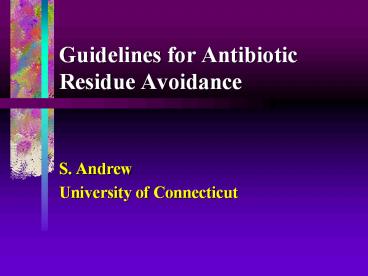Guidelines%20for%20Antibiotic%20Residue%20Avoidance - PowerPoint PPT Presentation
Title: Guidelines%20for%20Antibiotic%20Residue%20Avoidance
1
Guidelines for Antibiotic Residue Avoidance
- S. Andrew
- University of Connecticut
2
Why Should We be Concerned About Residues in
Milk?
The goal is to produce a nutritious, wholesome
food for consumers. It is essential to maintain
and foster consumer confidence. Profitability
3
Human Food Safety Issues Sensitivity to
antibiotics Immunological response Bacterial
resistance to antibiotics No link established
between animal use and human pathogen
antibiotic resistance (however, there is a
potential for this to occur)
4
Antibiotic Residue Defined as
Detection of antibiotic in milk 1. at or above
the tolerance or safe concentration for
approved drugs, or 2. at any concentration for
unapproved drugs 3. at any concentration
for illegal drugs
5
Antibiotic Routes of Administration
Intramammary Topical Oral
skin Injectable
feet Intramuscular teats
Intravenous eyes Intrauterine
Feed Additives
6
Major Use of Antibiotics is for the Treatment of
Mastitis
Intramammary Dry cow and lactation treatments
7
Top Five reasons for Residue Violations
1. Milking a treated dry or lactating
cow 2. Same milking unit for treated and un-
treated cows 3. One quarter treated, milk from
other three quarters put in tank 4.
Unaware that newly purchased animals were
treated 5. Fresh cow milk contained residues
from dry cow treatment
8
Why do Residues Occur? Lack of adequate
record-keeping Lack of understanding antibiotic
use Poor relationship between producer and
veterinarian Sischo, and
coworkers, 1997
9
Regulation of Antibiotic Residues in Milk
Milk is regulated at the bulk tank/tanker
truck level. Pasteurized Milk Ordinance
(PMO) a. under section 6
milk is sampled 4 times during any
consecutive 6 months.
10
b. Under Appendix N of the PMO - every tanker
truck is screened for beta-lactam antibiotics
beginning July, 1992 Penicillin
Cloxacillin Amoxicillin
Cephaprin Ampicillin Ceftiofur - bulk
tank also sampled
11
If the tanker truck sample is Positive
Negative sample re-tested
no further 2x
action if positive - traced re-tested
at back to bulk tank State Lab
Regulatory action
12
Milk is analyzed for antibiotic Residues
using Qualitative Tests The
tests used have been evaluated and accepted by
FDA for use with bulk tank/tanker truck milk.
of samples tested positive 1995
3,219,071 0.101 1996
3,310,772 0.106
Smucker, 1997
13
Therefore, approximately 99.9 of milk tested
is free of antibiotic residues
It appears that we are winning the
race! However, 3,507 positive loads in 1996
14
How to Reduce the Risk of Antibiotic Residue
Violations
1. Follow label directions for approved
drugs (treatment regimen and withdrawal
times) 2. Extra-label use of antibiotic only
under veterinarian guidance 3. Identify treated
animals and milk into separate bucket.
15
How to Reduce the Risk of Antibiotic Residue
Violations
4. Establish a herd health management
program 5. Establish effective
record-keeping 6. Education/communication with
all personnel involved with milking and
treating cows and heifers.
16
How to Reduce the Risk of Antibiotic Residue
Violations
7. Follow the 10-point Milk and Dairy
Beef Quality Assurance Program 2 Establish a
valid veterinarian/client/patient
relationship 8 Use antibiotic residue
screening tests for testing treated cows milk
17
At Which Level Should Milk be Tested?
Bulk Tank/Tanker Individual Truck
Cow
18
Ideally, screening milk from treated cows before
adding the milk to the bulk tank is financially
advantageous
However, Many cases of residue violations
are due to accidentally milking a dry-treated
cow or treated cow Also..
19
The screening tests have not been evaluated by
FDA for use with individual cows milk
Major concern is the potential for increased
false - positive outcomes. Results in
dumping acceptable milk.
20
The false-positive rate for screening tests used
with individual cow milk ranged from 0 -
83 Cullor and coworkers, 1994
Andrew and coworkers, 1997
Sischo and Burns, 1993
21
Screening milk from cows treated with an
antibiotic following the appropriate withholding
time
Positive result may be due to 1. Antibiotic
present above tolerance 2. Antibiotic present
below tolerance 3. False positive outcome
22
Factors Affecting False-PositiveRates of
Antibiotic Residue Screening Tests
Factors associated with
SCREENING TEST MILK _____ - Test
storage - Somatic cells
conditions - Milk fat and protein
- Operation of test - Milk sample
23
Steps to Optimize Screening Test Performance
for Individual Cow Milk
1. ESTABLISH AN EFFECTIVE MASTITIS CONTROL
PROGRAM! 2. Follow drug withholding times. 3.
Match the test to the drug. 4. Test visually
normal milk.
24
Steps to Optimize Screening Test Performance for
Individual Cow Milk
5. If result is positive, retest. 6. If positive
again, check milk quality and re-test in 24
hours. 7. If positive, send milk sample to milk
processor laboratory for testing.
25
Summary
Residue Avoidance Understanding how antibiotic
residues can occur can aid in residue
avoidance Using residue screening tests
26
Summary
Residue Avoidance Establish an effective herd
health program Education and communication
is essential
27
Goal! Producing high quality
milk maintains consumer confidence































